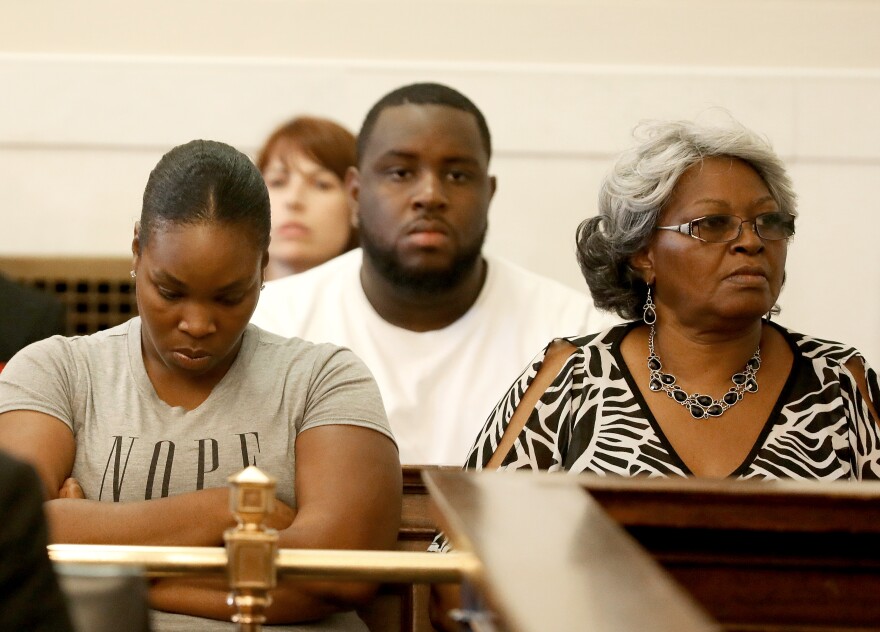Former University of Cincinnati police officer Ray Tensing's second trial on murder and voluntary manslaughter charges for the death of Sam DuBose has ended the same way as his first, in a hung jury. Hamilton County Judge Leslie Ghiz declared a mistrial Friday afternoon.
Jurors sent a note to the judge Friday morning saying they were hopelessly deadlocked after about 27 hours of deliberating. She sent them back to the discussion table. Nearly 31 hours after beginning deliberations they returned saying they were still unable to find consensus.
Ghiz says the prosecution has until July 24 to decide whether it will go for a third trial. Hamilton County Prosecutor Joe Deters' office says it won't have any comment until next week.
The DuBose family declined comment after the mistrial but Audrey DuBose, Sam's mother, issued a statement through her attorney.

"The family sincerely thanks the community for all of their support during these difficult times. The family commends the prosecutors for their strong presentation in this case but we are outraged that a second jury has now failed to convict Ray Tensing for the murder of our beloved Sam DuBose. We stand with the families of Terrance Crutcher of Oklahoma, Philando Castile of Minnesota, Freddie Gray of Maryland, and Sylville Smith of Wisconsin and demand justice for all these men who have been murdered by police officers who have escaped guilty verdicts. We demand another retrial. We call on the community to join us in peaceful protest of this unjust result."
The Tensing family has not spoken publicly about the incident. Tensing's attorney Stew Mathews tells WVXU the family does not wish to comment. He also didn't wish to say anything that "might jeopardize" his client. Mathews did tell a local television station Ray Tensing and his family are disappointed and would like resolution.
About The Jury
The jury consisted of seven white women, two African-American women, two white men, and one African-American man.
By comparison, the first trial jury consisted of six white women, four white men, and two African-American women.
Jurors range in occupations from healthcare professionals, information technology, and sales, to a nanny, and a PhD who does animal research. One juror has a son in law enforcement, another was in the military, and another is a musician. Many, but not all, said they had previously seen at least parts of the body camera video from the incident.
The Back Story
Tensing was charged with murder and voluntary manslaughter for shooting and killing Sam DuBose during a 2015 traffic stop. Tensing maintains he feared for his life as DuBose's car began to drive away. Tensing pulled his weapon and fired to avoid, he said, being dragged under DuBose's car.
The prosecution argued Tensing was in no imminent danger but rather forgot his training and reacted in an unreasonable manner. A forensic video expert analyzed Tensing's body camera footage and testified the car didn't begin moving until .178 seconds (less than a second) before Tensing fired the fatal shot.
Tensing's first trial ended in a hung jury in November, 2016.
Much of the testimony and witnesses were the same in the second trial as in the first. Perhaps the most striking differences were testimony from Cincinnati Police Sgt. Shannon Heine, who testified in the first trial, and defense video expert Scott Roder who did not.
Heine, a prosecution witness who was a lead investigator on the case, offered a surprising statement on the second day. Under questioning from the defense, Heine offered this opinion:
"Based on my time and training with internal investigations," she testified, "I thought I was looking at an officer-involved shooting where his actions may be determined to be justified based on the events surrounding the actual shooting and taking into consideration the information about the prior conduct of Mr. DuBose and Officer Tensing."
The prosecution twice objected, but the judge allowed Heine to make the statement, and she let it stand.
Defense witness Scott Roder does forensic animations and recreations. Though the judge didn't allow him to present his animations, she did allow him to serve as a video expert. His analysis of the body camera video drew a vastly different conclusion than the prosecution expert Grant Fredericks.
Roder testified that his analysis of Tensing's body camera video shows DuBose's car moved five to seven feet before the shot was fired. He also said the car began moving 2.4 seconds before the shot.
After resting its case, the prosecution requested the judge add a lesser count of reckless homicide for the jury to consider. Judge Leslie Ghiz declined saying she hadn't hear any testimony showing the incident meets the criteria for reckless homicide. She added that the prosecution could have added the lesser charge before the trial and chose not to; and that wasn't her job to make the change now.



